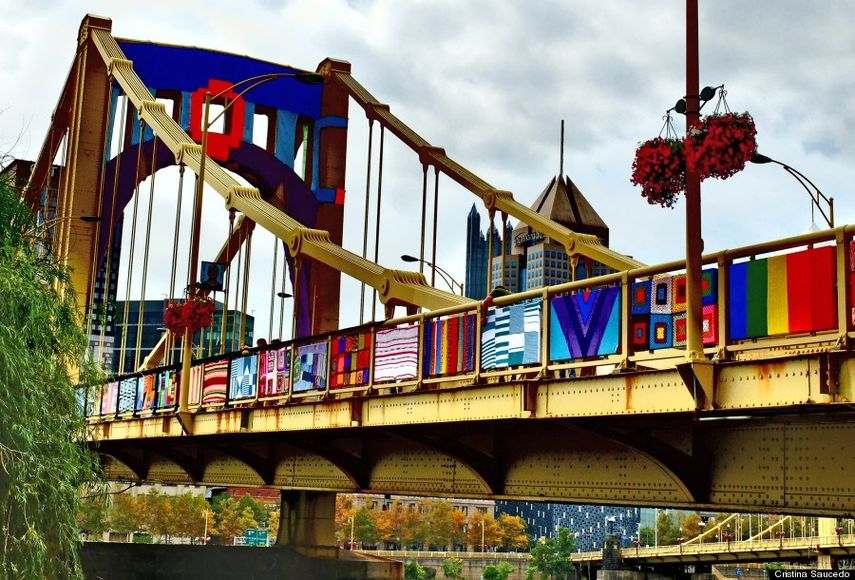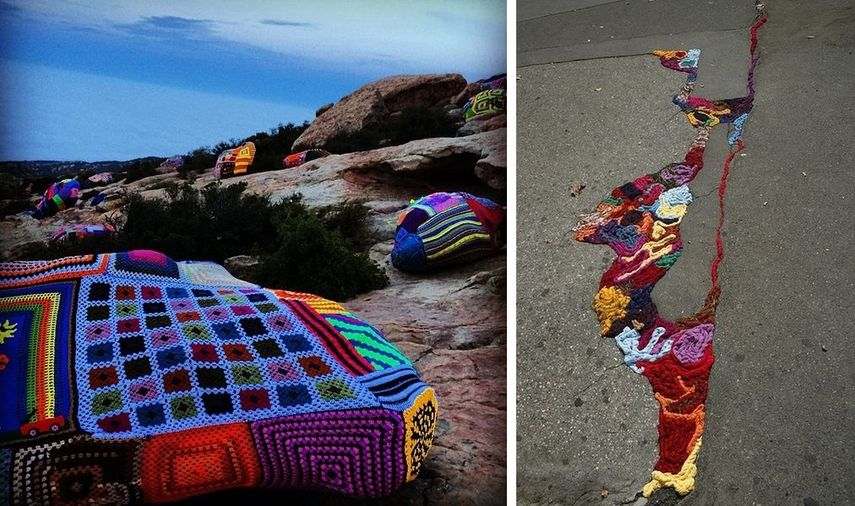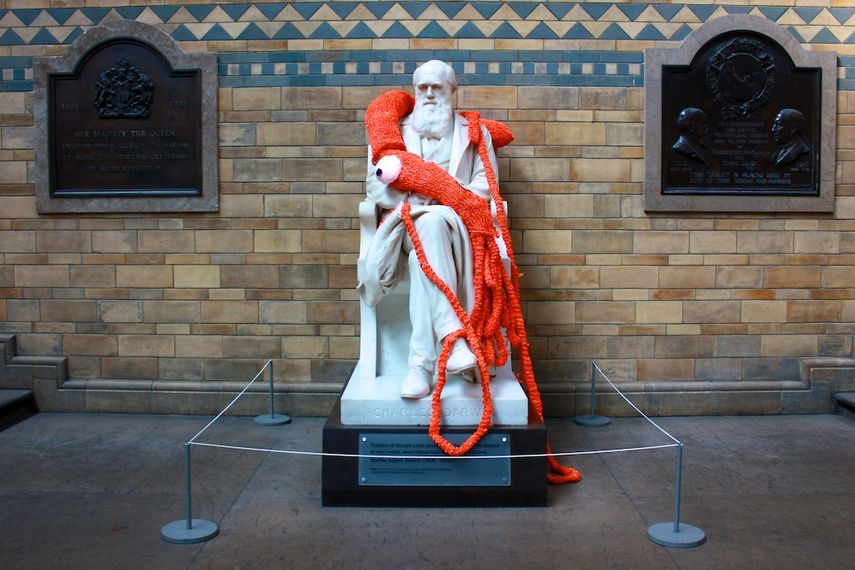6 When Artists Use Fabric Art in Nontraditional Ways in Urban Areas Outside It Is Called
Yarn bombing, yarnstorming, guerrilla knitting or crocheting, urban knitting or crocheting, graffiti knitting or crocheting - these are all names for a relatively new counterpoint in street art. Showing upwardly on trees, lamp posts, monuments, benches, and other elements of everyday cityscape, the practise is a new artistic grade that has been invading our streets in brilliant colors, bringing street art and craft together. As just 1 example of a range of new and creative forms of activism, artists have been using colorful displays of knitted or crochet yarn rather than paint to cover a vast range of objects in public space. It seems that wool and crafts bring virtually qualities such as actuality, or at least a longing, a desire to relate to our humanness, to ourselves and others, on deeper and more genuine level. Sentimental in a way that it seems to relate to our emotions first, yarn bombing is tactile in nature, connoting familiarity, intimacy, immediacy, or closeness. But just as any other street art practice, it tin vary greatly in style, aesthetics, and meaning.[1]
Yarn Documentary
Knitting and Crocheting as Art
As textiles became available to a large portion of social club in the 19th century due to a change of its production and consumption, diverse cloth and fiber arts and crafts such as sewing, weaving, embroidery or quilting, penetrated boilerplate households as activities mainly reserved for women. As often part-time and casual activities done at dwelling house, these crafts were identified withdomesticity andwomen'due south creativity and thus devalued and described as non-productive. Demoted to "feminine crafts", these practices became but a characteristic of an attractive and thrifty wife. With the ascent of the Feminist movement in the 1960s and 1970s, textiles and fiber began to be reintroduced into "high art". The move has reclaimed this realm to include these artistic practices that had traditionally been relegated to the lower status of "women'due south work". The Judy Chicago's installationDinner Political party from 1979 was one of the first acclaimed art pieces that included needlework and fabrics and it functioned as a symbolic history of women in Western civilization. Chicago and other artists such as Anni Albers, Faith Ringgold, Olga de Amaral, or Alighiero e Boetti, started bringing textiles and fibers into new contexts andexploring social and conceptual implications of their usage, paving the way for generations of textile and cobweb artists to come up.

The History of Yarn Bombing
The complete history of yarn bombing is lost in the mists of time and has been attributed to several dissimilar people. It is believed that the practice has first originated in the United States when Texas knitters tried to find a creative way to use their leftover and unfinished knitting projects, creating a form of "inoffensive graffiti". All the same, the start of the contemporary movement is oftentimes attributed to Magda Sayeg from Houston who has coined the term afterward first covering the door handle of her bazaar with a custom-made cozy in 2005. It attracted attention from passersby, inspiring Sayeg to venture further with the idea of roofing objects with yarn. She became curious about the idea of enhancing the ordinary, the mundane, even the ugly, and not taking abroad its identity or its functionality, merely just giving it a well-tailored suit out of knitting. Outset starting with small "yarn bombs" such as sign poles and burn hydrants in her hometown, she has presently ventured into transforming urban landscapes into her ain playground, ultimately leading her to found the yarn bombing crew,Knitta Please. As she explains, "nosotros yet require and desire something that's relatable".
While Sayeg's foray into yarn bombing was somewhat accidental, she spurred on a global community of yarn bombers, with yarn bombing crews founded across Europe, North America and Australia. I of the offset yarn bombing collectives was Knit the Urban center from London founded by Lauren O'Farrell who has moved the concept from elementary "cozies" to the "stitched story". O'Farrell was also the beginning to introduce the term "yarnstorming".
Magda Sayeg on Yarn Bombing for TED
The Purpose of Yarn Bombing
Initially, yarn bombing was almost exclusively nigh reclaiming and personalizing sterile public places and giving them a personal touch. Having a need to create something fun, unexpected and beautiful, these artists used yarn to create warmth and comfort inside the urban environs that was often perceived cold, depressing and unfriendly. By doing so, they pause the routine of the passers-by, making them terminate for a moment to admire the work or even criticize it. Also, past yarn bombing an ordinary and usually neglected object, they describe attention to it, telling a certain story or a joke. Over time, the art class has developed in a diverseness of ways through the practise of collectives and artists working worldwide, each with their ain agendas and aesthetics. Many yarn bombers see it as an act of subversion on a number of levels. While some tend to subvert norms about knitting and how it should be employed and enjoyed, others are about subverting ideas nearly femininity and domesticity by taking a homemaker medium into the society. On the other manus, others are fatigued to the peaceful protestation aspect of yarn bombing, often rallying around activist ideals such equally feminism, politics or anti-consumerist sentiments in their installation activities. Knitting protests can attract and speak to a unlike demographic than placards and public marches, as artistic approaches help alleviate the anxiety people are feeling without endangering them.[two]

Famous Yarnbombers
Contemporary yarn bombers are redefining the tradition of knit and crochet, bringing yarn out of the firm and into the earth. Reinventing our human relationship with this colorful tradition, they are making a creative stance while edifice 1 of contemporary art'southward hottest trends. Besides Magda Sayeg, one of the most well-known artists working in this field is Agata Oleksiak, too known equally Olek. Her work explores sexuality, feminist ideals and the evolution of communication through colors, conceptual exploration and meticulous particular. She constantly pushes boundaries between way, art, craft and public art, fluidly combining the sculptural and the fanciful. Employing the traditional technique of crocheting, she expresses everyday occurrences, inspirations and hopes to create a metaphor for the complexity and interconnectedness of our body and psychological processes. Founding one of the about famous yarn bombing collectives Knit the City, Lauren O'Farrell is best known for playing a major role in the beginnings of the UK graffiti knitting street art scene. Working under the moniker Deadly Knitshade, she has also created the Sew London craft customs. She is attributed with creating the "stitched story" style of graffiti knitting, using amigurumi and handmade objects to create themed artwork rather than the traditional cozy. Speaking almost their work, the members of her commonage country"it takes a woolly hold on forgotten public spaces and gives them a soul […] treats the whole world as an art gallery […] encourages others to bring their own urban center to life in ways only they can imagine ." London Kaye is another street and crochet artist who uses yarn equally her medium aiming to change appearance of cities and landscapes around the world. Her work ranges from whimsical to subversive."I honey that I'm doing something that'due south and so clearly a feminine craft, and putting information technology out in that location on the street with anybody else who'southward doing it", she explains. "Street art's definitely washed by mainly men. And I like to be able to bring that female perspective into the whole thing." [3] Although yarnbomb installations are typically found in urban areas,Stephen Duneier, aka Yarnbomber, is the start to introduce it to the wilderness with numerous permitted projects in Los Padres National Forest beginning in 2012. An gorging outdoorsman on a mission to depict people back to nature, Yarnbomber creates large-scale installation art in the mountains of Santa Barbara, California. Each of his projects exists for a maximum of 9 days before disappearing. One of his most famous works is the Cadger'southward Mouth Yarnbomb from 2014 when he wrapped 18 of the boulders 3,000 feet above Santa Barbara in handmade fiber fine art. Ane of the biggest community-led yarn bombing projection was Knit the Bridge from 2013, an outreach project by Fiberart International. The grassroots project brought many diverse communities of Pittsburg and Southwestern Pennsylvania together to create a large-scale, aesthetically stunning, fiberarts installation on the Andy Warhol Bridge in Pittsburgh. Over a thousand of knitters worked together and yarn bombed the entire bridge with more than 600 colorful blankets, covering the nearly of its metal construction.

The Questions on Ideals
Despite its popularity, this genre of street art found much criticism among other artists as well every bit art fans in general. It has been widely derided as a hipster fad or dismissed as cutesy. On the other paw, yarn bombing has spurred ethical controversies more than in one case. Olek has recently wrapped pieces in Cancun's Underwater Museum with her signature camo-graffiti crochet in a campaign to "save our seas". Yet, Mexican authorities and the Underwater Museum were looking to press charges equally the artist had tampered with the museum'due south art without permission and damaged sea life growing on the statues in a protected wildlife expanse in the process of creating her uninvited installation. This case has again brought up questions about the values surrounding the art and practise of graffiti knitting. Indeed, yarn bombing can be dissentious in some situations. Since the yarn doesn't stick to the surface like spray paint, information technology would somewhen be cut away in the best instance, or left to rot in the worst. Trees are oftentimes what people are concerned with. Some experts fence that the practice can harm trees growth or attract unwanted insects on it. If the artwork is left upward to run a risk and weather, there is a possibility it can temper with a natural habitat, or pollute it at least.[4] Some other result that has been raised regarding yarn bombing is using yarn for what some may call useless projects. Some feel that this copious amount of yarn could be used for other things, such as making clothes for those in demand, for example. Equally i Twitter user put information technology, "the commencement fourth dimension I saw yarn-bombing, I saw people sleeping under trees that were better dressed than they were." [5]

The Awareness and Responsibility
At that place'southward no question that the needle arts are having a moment. This year also saw the release of the critically acclaimed documentary Yarn about international yarn bombers. The film weaves together wool graffiti artists, circus performers, and structural designers into a visually-striking wait at these creative women. In improver, The Museum of Arts and Pattern in New York is currently exhibiting an elaborate exhibition titled Crochet Coral Reef. It celebrates 10 years of an ongoing projection by sisters Margaret and Christine Wertheim and their Los Angeles–based organization, the Institute For Figuring. Mixing crocheted yarn with plastic trash, the piece of work fuses mathematics, marine biology, feminist art practices, and craft to produce large-scale coralline landscapes, both beautiful and blighted. At once figurative, collaborative, worldly, and dispersed, the exhibition offers a tender response to the dual calamities facing marine life: climate change and plastic trash.[six]
In the midst of the growing popularity of the medium and do, yarn bombers should maintain an awareness of the environment they are working in. In club to do equally little impairment as possible, they should fix their works to a surface that cannot be contradistinct and affected. They should exercise the research on the site they are planning to cover in order not to destroy the creature habitat. Since the piece of work invades a public space, they should as well take a responsibility for it, making certain their statement meets their personal ethics.

Editors' Tip: Yarn Bombing: The Art of Crochet and Knit Graffiti
Yarn Bombing: The Art of Crochet and Knit Graffiti is the definitive guidebook to covert material street art. This total-color DIY book features twenty kickass patterns that range from hanging shoes and knitted motion-picture show frames to balaclavas and gauntlets, teaching readers how to create fuzzy adornments for lonely street article of furniture. Along the way, it provides tips on how to be as stealthy equally a ninja, demonstrates how to orchestrate a large-scale textile projection, and offers revealing information necessary to pattern your ain yarn graffiti tags. The book also includes interviews with members of the international community of textile artists and yarn bombers, and provides resource to help readers join the movement; it's besides brimming total of beautiful photographs and easy step-by-step instructions for knit and crochet installations and garments.
References:
- Harris, S. (2016) What is Yarn Bombing? Felt Magnet
- McGovern, A. (2014) Knit i, purl one: the mysteries of yarn bombing unraveled . The Chat
- Bearding. (2017) "Yarn bomber" hopes to bring new perspective to street art . CBS News
- Prain, L. (2014) On Yarn Bombing and Ideals . Leanne Prain
- Nagan, R.50. (2014) 'Yarn Bombing' Is The New Graffiti, But Is That OK? Odyssey
- Bearding. (2016) Crochet Coral Reef: TOXIC SEAS . Museum of Arts and Blueprint.
Featured image: Stephen Duneier - Tree Yarn Bombing, via pinterest.com; Stephen Duneier - Lizards Mouth Yarnbomb. All images for illustrative purposes only.
Source: https://www.widewalls.ch/magazine/what-is-yarn-bombing
Belum ada Komentar untuk "6 When Artists Use Fabric Art in Nontraditional Ways in Urban Areas Outside It Is Called"
Posting Komentar